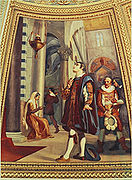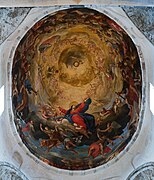Pisa Cathedral
| Pisa Cathedral Primatial Metropolitan Cathedral of the Assumption of Mary | |
|---|---|
Il Duomo di Santa Maria Assunta | |
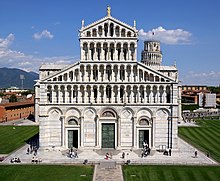 Pisa Cathedral, with theLeaning Towerin the background. | |
 | |
| 43°43′24″N10°23′45″E/ 43.723281°N 10.395845°E | |
| Location | Pisa |
| Country | Italy |
| Denomination | Catholic Church |
| Sui iurischurch | Latin Church |
| Website | Official website |
| History | |
| Consecrated | 26 September 1118 |
| Architecture | |
| Architect(s) | BuschetoandRainaldo |
| Style | Pisan Romanesque |
| Groundbreaking | 1063 |
| Completed | 1092 |
| Administration | |
| Archdiocese | Pisa |
This article includes alist of references,related reading,orexternal links,but its sources remain unclear because it lacksinline citations.(May 2024) |

Pisa Cathedral(Italian:Cattedrale Metropolitana Primaziale di Santa Maria Assunta; Duomo di Pisa) is a medievalCatholiccathedraldedicated to theAssumption of the Virgin Mary,in thePiazza dei MiracoliinPisa,Italy, the oldest of the three structures in the plaza followed by thePisa Baptistryand theCampanileknown as theLeaning Tower of Pisa.The cathedral is a notable example ofRomanesque architecture,in particular the style known asPisan Romanesque.[1]Consecratedin 1118, it is the seat of theArchbishop of Pisa.Construction began in 1063 and was completed in 1092. Additional enlargements and a newfacadewere built in the 12th century and the roof was replaced after damage from a fire in 1595.
History[edit]

Construction on the cathedral began in 1063 (1064 according to the Pisan calendar of the time) by the architectBuscheto,and expenses were paid using the spoils received fighting against the Muslims inSicilyin 1063.[2]It includes various stylistic elements: classical,Lombard-Emilian,Byzantine,andIslamic,drawing upon the international presence of Pisan merchants at that time. In the same year,St. Mark's Basilicabegan its reconstruction inVenice,evidence of a strong rivalry between the twomaritime republicsto see which could create the most beautiful and luxurious place of worship.
The church was erected outside Pisa's early medieval walls, to show that Pisa had no fear of being attacked.[citation needed]The chosen area had already been used in theLombard eraas anecropolisand at the beginning of the 11th century a church had been erected here, but never finished, that was to be namedSanta Maria.[citation needed]Buscheto's grand new church was initially calledSanta Maria Maggioreuntil it was officially namedSanta Maria Assunta.[citation needed]
In 1092 the cathedral was declared primatial church, archbishopDagoberthaving been given the title ofPrimatebyPope Urban II.The cathedral was consecrated in 1118 byPope Gelasius II,who belonged to theCaetanifamily which was powerful both in Pisa and in Rome.
In the early 12th century the cathedral was enlarged under the direction of architectRainaldo,who increased the length of the nave by adding threebaysconsistent with the original style of Buscheto, enlarged thetransept,and planned a new facade which was completed by workers under the direction of the sculptors Guglielmo andBiduino.[3]The exact date of the work is unclear: according to some, the work was done right after the death of Buscheto about the year 1100, though others say it was done closer to 1140. In any case, work was finished in 1180, as documented by the date written on the bronze knockers made byBonanno Pisanofound on the main door.
TheDecember 1187 papal electiontook place in Pisa Cathedral, with Paulino Scolari being electedPope Clement III.[4]
The structure's present appearance is the result of numerous restoration campaigns that were carried out in different eras. The first radical interventions occurred after the fire of 1595, following which the roof was replaced and sculptors from the workshop ofGiambologna,among whom were Gasparo Mola andPietro Tacca,created the three bronze doors of the facade. In the early 18th century began the redecoration of the inside walls of the cathedral with large paintings, the "quadroni", depicting stories of the blesseds and saints of Pisa. These works were made by the principal artists of the era, and a group of citizens arranged for the special financing of the project. Successive interventions occurred in the 19th century and included both internal and external modifications; among the latter was the removal of the original facade statues (presently in the cathedral museum) and their replacement with copies.
Other notable interventions include: the dismantling of Giovanni Pisano's pulpit between 1599 and 1601 that only in 1926 was reassembled and returned to the cathedral (with some original pieces missing, including the staircase); and the dismantling of the monument to Henry VII made byLupo di Francescothat was found in front of the door ofSan Ranieriand later substituted by a simpler, symbolic version.
Description[edit]
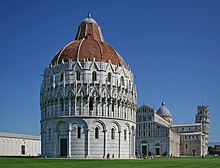
The original building plan was aGreek crosswith a grand cupola at the crossing, but today the plan is a Latin cross with a centralnaveflanked by two side aisles on each side, with the apse and transepts having three naves. The inside offers a spatial effect similar to that of the greatmosquesthanks to the use of raised lancet arches, the alternating layers of black and white marble, and theelliptical dome,inspired by the Moors. The presence of two raisedmatroneain the nave, with their solid, monolithic columns of granite, is a clear sign of Byzantine influence. Buscheto welcomed Islamic andArmenianinfluence.[5]
Exterior[edit]

The rich exterior decoration contains multicolored marble, mosaic, and numerous bronze objects from the spoils of war, among which is thePisa Griffin,now a copy. The arrival of the griffin in Pisa has been attributed to numerous Pisan military victories of the 11th and 12th centuries, includingthe 1087 Mahdia Campaignand the1113–15 Balearic Expedition.The griffin was placed on a platform atop a column rising from thegableabove theapseat the east end of the roof, probably as continuation of the original construction that started in 1064. In the early 19th century the original sculpture, which can now be seen in the cathedral museum, was removed from the roof and replaced with a copy. The high arches show Islamic and southern Italian influence.Ref?The blind arches with lozenge shapes recall similar structures inArmenia.Ref?The facade of grey and white marble, decorated with colored marble inserts, was built by Master Rainaldo. Above the three doorways are four levels of loggia divided by cornices with marble intarsia, behind which open single, double, and triple windows.

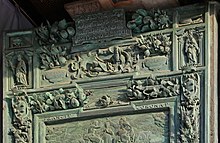
The cathedral was heavily damaged by a fire in 1595. The heavy bronze doors of the façade were newly designed, executed and completed in 1602 by sculptors from the circle ofGiambolognaon the expense ofFerdinando I de' Medici, the Grand Duke of Tuscany.At the top there is a Madonna and Child and, in the angles, the four evangelists. The tomb of Buscheto is found to the left of the north door of the facade.

Contrary to what might be thought, from the beginning the faithful entered the cathedral through the Gate ofSaint Rainerius,found in the south transept of the same name, which faces the bell tower. For townsfolk approaching by via Santa Maria it was the shortest way to enter the cathedral. The door wings were cast about 1180 byBonanno Pisano,and it is the only door not destroyed in 1595. The 24 bronzereliefsshow stories of the New Testament. This bronze portal is one of the first produced in Italy during the Middle Ages, and is a forerunner of the bronze doors created byAndrea Pisanofor theBaptisteryinFlorence(1329–1336).
Interior[edit]

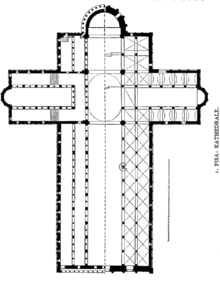
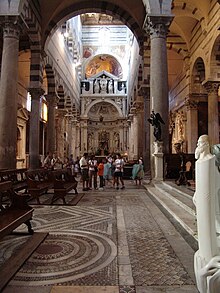
The interior, subdivided at the front into a centralnaveflanked by two side aisles on either side and with thetranseptandapsein three naves, is covered with white and black marble, with monolithic grey marble columns havingcorinthian capitals.It has a wooden 17th-centurycofferedceiling, painted and decorated with gold leaf, made by Domenico and Bartolomeo Atticciati; it bears the Medici coat of arms. Presumably the earlier ceiling was a structure with wooden trusses.
The inside of the dome, found where the central nave and the transepts cross, is decorated using a rare painting technique calledencaustic[6][7]and depicts the Virgin in glory with saints by the Pisan artistsOrazioandGirolamo Riminaldi(1627–1631). Restoration of the dome began in 2015 and was concluded in 2018.[8]
The granite Corinthian columns between the nave and the apse come from the mosque ofPalermo,and are Pisan spoils retained in 1063 after a successful joint attack with the Normans on the Muslims in that city.
The large mosaic in the apse ofChrist enthroned between the Virgin and Saint Johnis famous for the face of Saint John, painted by Cimabue in 1302, which miraculously survived the fire of 1595. This is the last work painted by Cimabue and the only work of his for which we have certified documentation. The work evokes the mosaics of the Byzantine and Norman churches found inCefalùandMonrealeinSicily.The mosaic, in large part made by Francesco da Pisa, was brought to completion by Vincino da Pistoia with the Madonna on the left side (1320).
Among the medieval works that avoided destruction during the fire of 1595 are the fresco of the Madonna with Child in the triumphal arch by the Pisan artist Maestro di San Torpè, as well as thecosmatipavement, work rarely found outside ofLazio.It was made using inlaid marble to create geometric patterns (mid-12th century). Other fresco fragments from the late medieval period have survived, among which isSaint Jeromeon one of the four central pylons, as well asSaint John the Bapstist,a Crucifixion, and Saints Cosmas and Damian on one of the pylons near the entrance, partially hidden by the entry way.
The pulpit[edit]
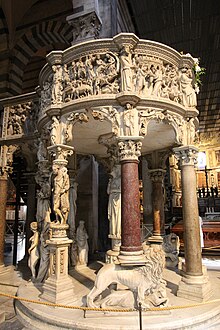
The pulpit, a masterpiece made byGiovanni Pisano(1302–1310), survived the fire but was dismantled during the work of restoration and was not reassembled until 1926. With its intricate architecture and its complex sculptural decoration the work presents one of the most sweeping narratives of the 13th-century imagination which reflects the religious renewal and fervor of the era. On the slightly curved panels are sculpted with an expressive language the episodes of the life of Christ. The structure is polygonal (as in similar pulpits in thepulpit in the Pisa Baptisteryby Giovanni's fatherNicola Pisano(1260), in theSiena Cathedral Pulpit,and in Giovanni'spulpit of Sant' Andrea, Pistoia;but this is the first example in a work of this type in which the panels are slightly curved. Other features include:
the presence of caryatids, sculpted figures in place of simple columns, that symbolize the Virtues; the use of scrolled 'shelving' in place of arches to support the raised platform; the sense of movement given by the numerous figures that fill up every empty space. For these qualities united to the skillful narrative art of the nine scenes the pulpit is generally considered to be a masterpiece, but more broadly it is considered a masterpiece of Italian gothic sculpture. This pulpit substituted the previous one made by Guglielmo (1157–1162) that was sent to the Cagliari Cathedral. Given the lack of documentation prior to its dismantling, the pulpit was placed in a location different from its original spot, and without doubt, its parts are not in their original positions either. It is unknown if the original work possessed a marble staircase.
Works of art[edit]
The church also houses the relics ofSaint Rainerius,patron saint of Pisa, and the fragmentary tomb ofHenry VII, Holy Roman Emperor,who died at Buonconvento while holding Florence, in vain, under siege. The tomb, sculpted byTino da Camainobetween 1313 and 1315, was also dismantled then reconstructed and today sits in the righttransept,while its original position was in the center of theapseas a sign of the city'sghibbelineadherence. Moved several times for political reasons, it eventually was separated into many parts (some inside the church, some on the facade, others in theCamposanto,and yet others in the cathedral museum).
The 27 paintings that cover the galleries behind the main altar, depictingStories of the Old TestamentandStories of the Life of Christ,were made between the 16th and 17th centuries mostly by Tuscan artists, among whom areAndrea del Sarto(three works:Saint Agnes,Saints Catherine and Margaret,andSaints Peter and John the Baptist),il Sodoma,andDomenico Beccafumi(Stories of Moses and the Evangelists).
Numerous and prestigious are the sacred furnishings of the church, including the bronze crucifix found on the main altar, and the angel candleholders placed at the ends of the rich marble transenna, made byGiambologna,as well as the large ciborium in silver designed byGiovanni Battista Foggini(1678–86) on the altar of the Blessed Sacrament chapel. On the numerous side altars are located 16th and 17th century paintings. Among these works are theOur Lady of Graceswith Saints,by the FlorentineManneristAndrea del Sarto, and theMadonna Enthroned with Saintsin the right transept, byPerin del Vaga,a student ofRaphael,both finished byGiovanni Antonio Sogliani.In theBaroquestyle are: theDisputation of the Holy Sacramentby the Sienese painterFrancesco Vanni,and theCross with Saintsby GenoanGiovanni Battista Paggi.Particularly well-loved is the 13th century image of aMadonna and Child,called theMadonna Under the Organ,attributed toBerlinghiero Berlinghieriof Volterra.
The cathedral, like the leaning bell tower, is sinking perceptibly into the ground, and a few indications of this instability are visible. For example, the difference in the floor levels of the original nave of Buscheto and the bays which were added later by Rainaldo.

The cathedral's originalgràdule?,constructed by Giovanni Pisano and dating from the late 13th century, were replaced in 1865 by the presentparvise.These marble panels, decorated with carved animal figures and faces, were used to create a low wall which was placed close to the outer perimeter of the cathedral and which created an enclosure that provided space for the numeroussarcophagifrom the Roman period. During the Middle Ages, these panels were reused for burials of nobles (among themBeatrice of Lorraine) and other well known persons, such as the architect Buscheto himself, who is buried under the outer left arch of the west facade. Some fragments are still visible in the cathedral museum, while the sarcophagi were all moved inside the fence of theCamposanto.
Organs[edit]
Inside the cathedral are found the Serassiorganmade between 1831 and 1835, as well as an organ made in 1977 by the company Mascioni of Cuvio.
Main artists who worked in the cathedral[edit]
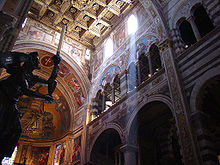
- Buscheto(architect)
- Rainaldo (elongation of nave, bays, and facade)
- Guglielmo(original pulpit and marble decoration)
The three artists listed above are buried in the cathedral.
- Cimabue(mosaic in the apse)
- Tino da Camaino(funeral monument of Henry VII)
- Bonanno Pisano(original bronze doors)
- Giambolognaand his school (bronze doors of the facade)
- Giovanni Pisano(pulpit)
- Nicola Pisanoe Giovanni Pisano (crown around the dome)Ref?
- Pietro Tacca(crucifix and angel candle bearers)
- Andrea del Sarto(various paintings)
- Il Sodoma(various paintings)
- Giovanni Battista Tempesti(various paintings)
- Biduino(marble decoration)
- Giuliano Vangi(pulpit and main altar)
- Orazio RiminaldiandGirolamo Riminaldi(fresco in the dome)
- Vincenzo Possenti(chandelier)
Of further interest[edit]
- At the end of the 10th century Pisa established March 25 as the beginning of its new year. This date was considered very important because it is both theFeast of the Annunciation(occurring nine months before Christ's birth on December 25) and it falls very close to thespring equinox.To mark the beginning of the Pisan new year a system was devised in the cathedral whereby a beam of light shines through a round window on the south side of the nave and, precisely at noon on March 25, lands on the same spot every year: on top of a shelf affixed to a pylon on the opposite side of the church. This shelf rests on a marble egg, a symbol of birth and new life. In 1750 the first day of the new year was officially changed to January 1, but this event is still celebrated every year accompanied by solemn religious and civic celebrations.[9]
- The lamp at the center of the nave is calledGalileo'slamp, because a legend says that the great scientist formulated his theory ofisochronismof thependulumwhile watching its oscillations from the roof of the nave. The original, however, smaller and very different than this one, is found today in the Camposanto.
- On the north side, to the left side of the facade in front of the Camposanto at about eye level, is an original piece of Roman marble (as testified to by its decoration that can still in part be seen), on which are a series of small black marks. Legend says that these marks were left by the devil when he climbed up to the dome attempting to stop its construction, and so they are referred to as thescratches of the devil.(The legend also says that out of spite the number of scratches always changes when counted.)
- Legend has it that theamphoraplaced on a small column on the right side of the apse was used by Christ at thewedding feast of Canawhen he turned water into wine.
- Pope Gregory VIIIis buried in the cathedral.
-
The ray of light on the Feast of the Annunciation
-
Galileo observing the lamp
-
The so-calledLamp of Galileoand the cupola of the dome
-
The original lamp seen by Galileo
-
The amphora said to be from the wedding feast of Cana.
Other images[edit]
-
Aerial view with the complex of the Piazza dei Miracoli from the south
-
Eastern end of the cathedral
-
A copy of the bronzePisa Griffinin its original position on the cathedral roof
-
The bronzePisa Griffinin the cathedral museum
-
Door of Saint RainierbyBonanno Pisano.19th century photography byGiacomo Brogi
-
Tomb altar of Saint Rainier, patron saint of Pisa
-
Detail of the pulpit,Hercules,a rare medieval depiction of a nude
-
Encaustic painting of theAssumptionin the dome
Note[edit]
- ^Watkin, David (2005).A History of Western Architecture.London: Laurence King Publishing. p. 148.ISBN1856694593.
- ^Morris, Colin (1991).The Papal Monarchy: The Western Church from 1050 to 1250.Oxford University Press. p. 147.ISBN0198269250.Retrieved7 November2016.
- ^Valli, Franca Manenti (2016).Pisa: lo spazio e il sacro,with Preface byGianfranco Ravasi,Edizioni Polistampa, Firenze
- ^"Cronica de Mailros", quoted by Watterich II, p. 693. Gregorovius IV 2, p. 616.
- ^Guida rapida d'Italia,Touring Club Italiano, 1994, vol. 3, pag. 186.
- ^Carli, Enzo (1989).Il Duomo di Pisa: il Battistero, il Campanile,p. 107.
- ^"La cattedrale si fa bella per la festa dei 950 anni".Il Tirreno.24 November 2015.
- ^Amsen, Eva (12 April 2019)."Bacteria Cleaned Paintings In Pisa Cathedral".Forbes.com.Retrieved9 July2020.
- ^"25 marzo: Capodanno Pisano".Associazione degli Amici di Pisa.Archived fromthe originalon 8 November 2016.Retrieved8 November2016.
See also[edit]
- Piazza dei Miracoli
- Archdiocese of Pisa
- Leaning Tower of Pisa
- Baptistery of Pisa
- History of medieval Arabic and Western European domes
External links[edit]
- Places of Faith in Tuscany (in both Italian and English)
- Stained glass windows of the cathedral of Pisa (In Italian)


